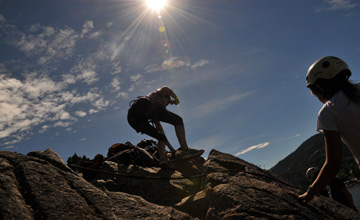Early in the morning, we left the City of San Martín de los Andes to follow the 7-Lakes Road towards Villa La Angostura and then cross onto Chile through Cardenal Samoré International Pass, formerly known as Puyehue Pass.
We left Lake Lácar and its impeccable port crowded with sailing boats behind and after a 20-kilometer stretch uphill, we stopped at Arroyo Partido (Parted Creek). This is a natural phenomenon that causes this creek to be divided into two arms: one of them carries its waters towards the Pacific Ocean through the Lácar basin and the other arm goes down to the Atlantic through the Collón Cura, Limay and Negro Rivers.
30 kilometers after our ride began, a viewpoint let us see the quiet deep blue waters of Lake Machónico from the heights. We drove on up to Lakes Falkner and Villarino, whose majesty and beautiful beaches where to spend the day and camp compete with one another.
Crossing over to Chile through Cardenal Samoré Pass
It was at this spot where the rubble road began and Lake Escondido appeared to our right. A thick elevated forest of native species barely let us see this water body whose name in Spanish stands for ’Hidden’.
Our photographic camera did not miss this detail. These images would let us recreate the unique scenes of the Patagonian Andes once we went back home.
We had already traveled along 80 kilometers when we got past the Lake Espejo viewpoint. Featuring a large size, its waters are sheltered from the winds by a coihue wood. The road continues uphill and Lake Correntoso escorted us for a while before we headed for Chile. An inn and a primitive campsite owned by a family that has dwelled in this area forever stand out along with the animal pens.
A little farther ahead we turned right into a paved road that leads to the international pass. We stopped at a vantage point over Lake Espejo and saw its beaches of volcanic sand.
The Customs and Gendarmería Nacional Argentina buildings invited us to carry out all the necessary proceedings to leave the country.
Invisible International Border
The signs give notice of where the real border lies. At that very special moment when we left our country behind and entered neighboring Chile, the forest and the smells of nature did not appear the same. We were in Chile and we carried out the proceedings again, this time before the Chilean authorities.
Once in Chile, on the first stretch of Route 215, which featured ample bends, we went downhill through the Valdivian rainforest. The sign posts that read Puyehue Hot Springs, Antillanca Volcano and its ski resort and how many kilometers still separated us from Osorno appeared soon.
Upon reaching Osorno, we found a wide range of options to visit: Frutillar, Puerto Varas and Puerto Montt. We let ourselves be dazzled by the tourist attractions and the scenes of southern Chile.
We will never forget that morning when the low clouds faded as the day reflected its light upon the surface of every water body on the way.
Mónica Pons
Jorge González






























